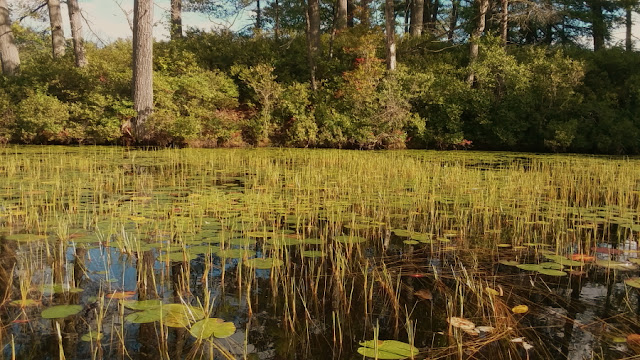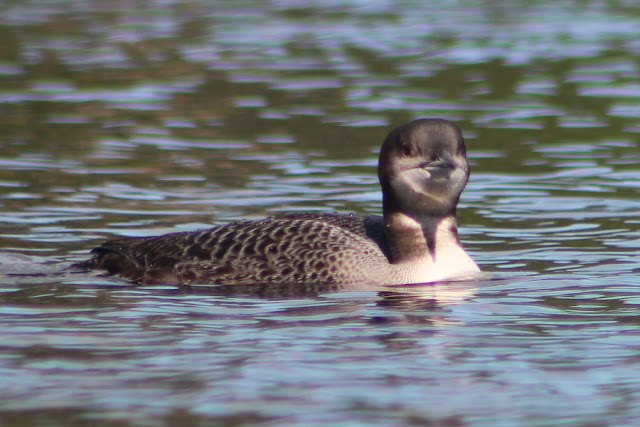A warm, calm day in September is a beautiful time in the Lakes Region.
I took a leisurely paddle around Lake Wicwas to absorb the late summer sun and see what's happening this time of the year, but even before I got onto the water this pretty little caterpillar caught my eye.
 |
Banded Tussock Moth (Halysidota tessellaris)
Descriptio
|
This is one of several species of tussock moth around the lakes, and is one of the culprits behind the droppings left on surfaces underneath oak and maple trees.
Once on the water I noticed that the morning rain, though evaporated from all the leaves on the trees, was still beaded up on the lily pads.
The soft colors of fall are already appearing, especially in the afternoon when the sun is getting low in the sky.
At one point a small flock of geese came straight towards me, clearly aiming for splash down until they realized I was in the middle of their landing strip, at which point they circled away and landed father down the lake where there were no obstacles to avoid.
 |
| Six geese fly with a little fall color showing in the trees behind. |
The geese will soon be forming large Vs in the sky as they start their venture southward.
During my paddle I came across both Harley and Davidson - in different locations - and they're both looking strong and independent, making long dives for fish.
But they still enjoy the company of their parents, and the occasional hand out from mom or dad, as caught by artist and photographer Amy Wilson.
 |
| Hanging with the parents, and almost a large. |
 |
| Thanks mom. |
Thanks for sharing Amy!
The only other animal I came across was a painted turtle sunning itself.
I did encounter one new plant, a colorful shrub on the shore of Sheep Island, which is highly appropriate since one of its common names is "sheepberry".
 |
| Nannyberry viburnum (Viburnam leganto) |
In addition to being spectacular in color, the berries are reportedly edible and quite sweet. The plant provides food and cover for a range of birds and small mammals and I think I've seen signs of nannyberry fruit in the scat of fox and coyote.
It was an enjoyable afternoon on the lake.
That same day, before my lake excursion and during the morning showers, we were visited by a large flock of robins.
 |
| American robin (Turdus migratorius) |
The flock included immature robins of various ages, as robins have multiple broods during the summer.
 |
| This bird is probably from an early brood. |
 |
| While the spotting on this one's chest indicates it's younger, |
Robins have some interesting social behavior, particularly the males. Even during mating season the males will often roost overnight together in a common spot, leaving the females alone on the nest. (Kind of like guys night, every night.) But in the fall, many family units will group together in flocks of up to 100 birds, staying together through the winter until they start dividing up territory in the spring for nesting. The flock I saw was over 30 birds, but it was impossible to count them as they hopped around everywhere finding tiny morsels on the ground.
 |
| Scratch and peck. |
So don't put away those boats yet, as there's still plenty of great fall weather to be enjoyed out on the water, and we haven't even started with the foliage yet!
 |
| Well, maybe just a hint. |






















































